reaxys数据库使用方法
《Reaxys数据库》课件

Reaxys数据库的案例分析
化学合成案例
通过Reaxys的反应数据库和 合成路径检索,化学家成功 找到了一种更高效的合成路 线。
药物研发案例
Reaxys提供的药物化学数据 和结构活性相关性信息帮助 研究团队优化了药物设计方 案。
材料研究案例
通过Reaxys收录的材料相关 数据,研究者成功发现了一 种新型材料并改善了其性能。
Reaxys不仅提供了大量数据,还具备数据的导出、统计分析和化学结构检索等多种功能。
Reaxys数据库的应用领域
化学合成
Reaxys的反应数据库和合成路径 检索功能帮助化学家优化合成路 线,提高合成效率。
药物研究
Reaxys提供了大量的药物化学数 据和结构活性相关性信息,支持 药物研发和优化。
材料科学
用户友好界面
Reaxys具有直观的界面设计和强大的搜索功能,方便用户快速获取所需信息。
Reaxys数据库的特点
1 全面性
Reaxys涵盖了化学各个领域的数据,包括有机化学、无机化学、分析化学等。
2 最新性
Reaxys的数据源包括全球顶尖学术期刊和专利数据库,保证了数据的及时性和准确性。
3 多功能性
总结和展望
通过本次分享,我们了解到Reaxys数据库在化学研究和数据分析方面的重要 性和广泛应用。相信通过使用Reaxys,我们能够进一步推动化学科学的发展 和创新。
Reaxys数据的导出和分析
1 数据导出
2 统计分析
3 化学结构预测
用户可以将Reaxys中的数 据导出为Excel、CSV等 格式,方便进一步分析和 处理。
Reaxys提供了丰富的数据 统计分析工具,帮助用户 深入挖掘数据并提取有价 值的信息。
reaxys数据库使用方法

化学属性统计
Reaxys提供了化学属性统计功能, 用户可以对查询结果进行各种统计,
如分子量分布、沸点分布等。
结构相似性分析
用户可以利用Reaxys进行结构相似 性分析,找出结构相似的化合物,有
助于发现潜在的先导化合物。
总结词
根据用户需求,定制数据导出格式和内容, 方便用户进行后续数据处理和分析。
详细描述
Reaxys数据库支持多种数据导出格式,如CSV、 Excel等,用户可以根据自己的需求选择导出的数据 字段和格式,以便于在后续数据处理和分析中更好 地利用这些数据。
总结词
根据用户需求,定制数据分析方法和报告,提供专业的数据分析支持。
02
03
反应详情展示
用户可以查看反应的详细信息,包括 反应条件、催化剂、溶剂等,有助于 深入理解反应过程。
结果导
CSV格式
用户可以将查询结果导出为CSV格式,方便在Excel 等电子表格软件中进行进一步处理和分析。
PDF格式
Reaxys还支持将结果导出为PDF格式,方便用户进行 打印和分享。
原格式复制
该数据库由Elsevier公司开发,经过 多年的积累和更新,已经成为科研工 作者进行化学、材料和药物研究的重 要工具。
数据库特点
数据全面
Reaxys数据库包含了来自全球各 地的化学物质、反应、专利和科 学文献等数据,数据量庞大且全 面。
更新及时
Reaxys数据库的数据更新非常及 时,能够提供最新的科研成果和 专利信息。
用户可以通过Reaxys网站上的在线表单或联系客服申 请定制服务,提供具体需求和数据要求。
定制服务的时间和费用根据具体需求和数据量而定,需 要与客服人员进一步商议。
Reaxys快速参考指南
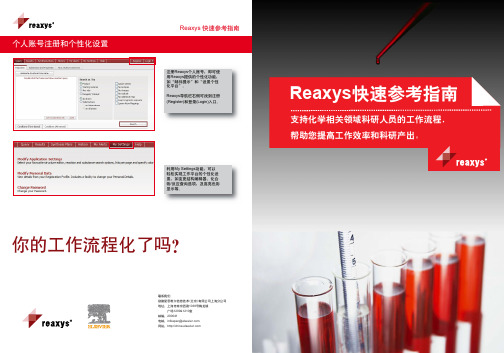
5
化合物信息 该化合物的详细信息 化合物可用数据 可用信息如果是来源自Gmelin 数据库的话,会出现相应的提 示标志(Gmelin Flag)
1
快速检索 可以直接输入作者,期刊, 专利号,发表年等查询项, 不同查询项间默认的逻辑 关系是 AND
2
文本查询可选列表 在输入的过程中,会出现可供选 择的条目 扩展索引功能 点击 可以打开扩展后的索引条 目进行浏览和选择
利用My Settings功能,可以 轻松实现工作平台的个性化设 置,如变更结构编辑器、化合 物/反应查询选项,及高亮色彩 显示等。
你的工作流程化了吗?
联系我们 励德爱思唯尔信息技术(北京)有限公司上海分公司 地址:上海市南京西路1038号梅龙镇 广场1209&1210室 邮编:200041 电邮:infoapac@ 网站:
•
•
•
7
检索结果 检索结果的概要信息
•
1
2
Reaxys 快速参考指南
Reaxys 快速参考指南
反应查询结果及导出
5 1 4
合成路线设计
1 2
3 2 4 3 2
5
备注: 所有形式的检索 (反应,化合物以 及文献)其检索结 果页面中都可以 找到导出(Output) 功能
5
6
1
化合物下拉菜单 点击 ,将会跳出包含化 合物信息及子选项的菜单 参考文献详细信息 题目,摘要;全文链接 (如ScienceDirect);引 文链接(Scopus)
3
购买信息 查询化合物商品的供应商信息 (eMolecules/Symyx ACD) 查询结果的排序功能 可以按照不同的标准对结果进 行升序/降序排列。如:原料/产 物的易得性,产率,参考文献 数量等
Reaxys平台使用方法

在线帮助文档
用户手册
01
提供Reaxys平台的详细操作指南,包括功能介绍、界面说明和
常见问题解答等。
视频教程
02
制作了一系列操作演示视频,帮助用户快速掌握平台的使用方
法和技巧。
知识库
03
整理了丰富的专业知识和操作经验,用户可随时查阅以解决实
际操作中遇到的问题。
培训课程与研讨会
线上培训课程
定期举办线上培训课程,由专业讲师指导用 户进行实际操作,提高使用技能。
登录与系统配置
总结词:建立连接
详细描述:首先,用户需要访问Reaxys平台官网,并注册一个账户。注册成功后 ,用户可以使用注册的账号和密码登录平台。在登录后,用户可以根据自己的需 求和偏好进行系统配置,例如选择语言、调整界面布局等。
数据库检索
总结词:信息获取
详细描述:Reaxys平台拥有庞大的化学物质和反应数据库,用户可以通过简单或高级检索方式,输入关键词、化合物名称、 CAS号等信息,快速获取所需的化学物质和反应数据。数据库检索是平台的核心功能之一,能够帮助用户快速获取所需信息 。
相似结构检索
利用Reaxys平台的相似结构检索功能,可以找到与目标化合物相似的化合物,有助于 拓展研究思路。
反应条件检索
反应条件筛选
通过设定反应条件,如温度、压力、溶 剂等,来筛选符合特定反应条件的相关 文献和实验数据。
VS
条件组合检索
可以同时设定多个反应条件进行组合检索 ,以获取更精确的结果。
组合检索
高级检索功能
总结词:定制查询
详细描述:除了基本的数据库检索功能外,Reaxys平台还提供高级检索功能,允许用户根据自己的需 求定制查询条件。通过高级检索功能,用户可以组合多个条件进行筛选,从而获得更加精确的结果。 高级检索功能提高了检索的灵活性和准确性,使用户能够更好地满足自己的信息需求。
Reaxys操作教程
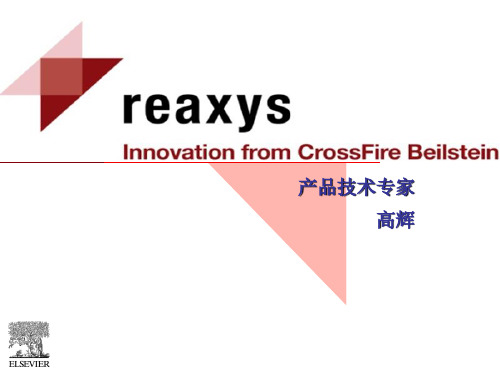
> 每年出版2000多种期刊和1900种新书 ,领域涵盖医学、生命科学、自然科学和 社会科学等占全球科技期刊的25%
> 180个国家,3000万科研人员必不可少的科技信息资源
全球最全面的科学期刊和在线期刊与科学数据服务商, 主要产品有: Scopus —全球最大的文摘与引文数据库 ScienceDirect —全球最大的外文期刊全文数据库 CrossFire:Beilstein—全球最全的有机化学数值和事实库 Patent Chemistry—化学专利数据库 Gmelin—当今最全面的无机与金属有机化学事 实数据库 Reaxys — Crossfire的升级产品 PharmaPendium —综合性药物安全性数据的关键来源
化学结构相关的化学、物理等方面的性质
化学反应相关的各种数据 详细的药理学,环境病毒学,生态学等信息资源 Patent Chemistry Database: Beilstein的完美补充 涵盖的国际专利类别[IPC](1976年之后) C07 有机化学 A61K 药物(医药,牙医,化妆品制备) A01N 生物杀灭剂(农用化学品,消毒剂等) C09B 染料(可能具有药理学活性)
>检索功能: Reaxys提供了各种先进高效的检索方法与二次筛选 的功能综合应用,可以帮助用户快速从海量的数据中找出所需 要的信息。
>界面:十分友好,易于操作,浏览方便。 >检索结果的处理:得到了很大程度的简化,可以十分方便的导 出数据并生成报告。
感谢各位的参与和支持 高辉 phoenixgao@
不定位的R取代基的查询结果(Grid)
子结构查询3:Atom list 查询
3、化学反应检索:例一
查询一条如图所示的反应
Reaxys使用方法

04
Reaxys高级功能
定制化ቤተ መጻሕፍቲ ባይዱ询
总结词
灵活的查询方式
详细描述
Reaxys提供多种定制化查询方式,用户可以根据自己的 需求选择合适的查询条件,如化学物质名称、分子式、结 构片段等,进行精确或模糊查询。
总结词
高效的数据筛选
详细描述
通过高级查询功能,用户可以筛选出符合特定条件的数据 ,如特定分子量范围、特定活性或某一特定类型的反应等 ,大大提高了数据筛选的效率和准确性。
02
它整合了多个数据库和工具,提供一站式的化学信 息检索、分析和可视化功能。
03
Reaxys涵盖了广泛的化学领域,包括有机化学、无 机化学、材料科学、药物研发等。
产品特点
高效检索
Reaxys提供了多种检索方式,包 括结构检索、反应检索、属性检 索等,帮助用户快速找到所需数 据。
数据分析
Reaxys提供了丰富的数据分析工 具,如化学结构相似性分析、分 子性质计算、化学反应路径分析 等。
感谢您的观看
THANKS
总结词
多维度数据展示
详细描述
Reaxys支持将查询结果以多种形式展示,如表格、图表 和地图等,方便用户从不同维度对数据进行深入分析和解 读。
结构解析与合成
总结词
强大的结构解析功能
总结词
模拟合成路径
详细描述
Reaxys具备强大的结构解析功能,能够自动识别和提取 化学物质的结构信息,为化学物质的合成、反应机制研究 等提供有力支持。
案例二:材料科学中的晶体结构解析
总结词:结构解析
详细描述:Reaxys数据库包含了大量已知材料的晶体结构数据,为材料科学领域的学者提供可靠的晶 体结构解析参考,有助于深入理解材料的物理和化学性质。
Reaxys使用反应检索技巧

42
检索到的结果
检索到的反应,存在 NO2和X在邻位的,也 存在对位的反应
43
如何对反应进行筛选
• 想要的一定属于这个结果集的子集,可以直接使用过滤工具
44
输入限定的结构
1,打开元素周期表,选择Atom List定义C,N 2:在6元环上,将其余4个C全部换成List
45
添加结构后的界面
46
最后的结果
这种检索,出来 的NO2和X都处 于邻位
47
Reaxys使用指南
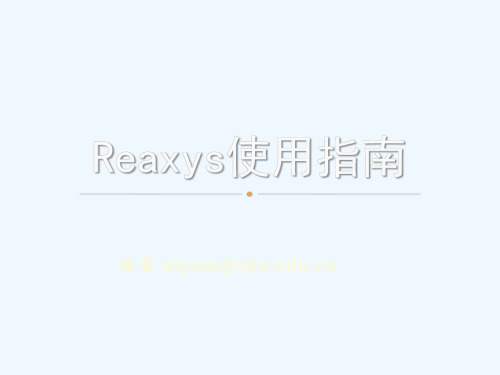
第四讲习题1:文献检索入口(6个)
Research Topic Author Name Company Name Document Identifier Journal Patent Tags
例2:检索吸入时有平喘疗效的化合物
获得检索结果
分析 物 质
设置 预警
区
展示
区
精
炼
区
物质
性质
例2:检索吸入时有平喘疗效的化合物
定制预警 默认 注册 邮箱
推送 频率
例2:检索吸入时有平喘疗效的化合物
查看药理数据
点击 查看 详情
例2:检索吸入时有平喘疗效的化合物
查看药理数据:含浓度、用量、方法等 浮动 窗格
结果 数据
文献信息
例3:结构检索化合物
广义基团(Generics)设置 原素列表(Atom list)设置
例3:结构检索化合物
设置广义基团
例3:结构检索化合物
设置广义基团
鼠标点住连接位置, 向下拖动,画出广
义基团
例3:结构检索化合物
广义基团设置成功
广义基团设置 成功
例3:结构检索化合物
检索产率大于等于75%的反应
例1:药物来氟米特的合成路线设计
设计合成路线图
例1:药物来氟米特的合成路线设计
设计合成路线图
例1:药物来氟米特的合成路线设计
设计合成路线图
例1:药物来氟米特的合成路线设计
添加合适的反应到合成路线图
例1:药物来氟米特的合成路线设计
可保存合成路线图
例1:药物来氟米特的合成路线设计
例4:检索近五年发表的关于大肠癌化疗药 物的文献,查看发文数量最多的期刊,并以 PDF格式导出该期刊2014年发表的1篇文献。
Reaxys数据库的使用

Company Logo
合成路线
Company Logo
数据保存
Company Logo
Company Logo
Company Logo
Company Logo
Company Logo
检索结果
Company Logo
反应检索(半反应查询)
CrossFire Gmelin Database: 全面的无机化学和金属有机化学数值 和事实库 1772年至今,3个月更新一次 详细的理化性质、地质学,矿物学, 冶金学,材料学等方面的信息资源
Reaxys是什么?
Reaxys不需要安装客户端软件,使用方便; Reaxys功能不仅强大,而且使用界面也符合大众 使用习惯,容易上手 Reaxys 将Beilstein/Patent/Gmelin三个 数据库整合为一个 Reaxys能把检索结果按照收率、催化剂等条件 进行二次过滤 ReaxUnion of Pure and Applied Chemistry (IUPAC) 国际纯粹与应 用化学联合会给出的一个一种化学结构的唯一识别码International Chemical Identifier (InChI) SMILES(Simplified molecular input line entry specification),简化分子 线性输入规范.由于SMILES用一串字符来描述一个三维化学结构,它 必然要将化学结构转化成一个生成树,此系统采用纵向优先遍历树 算法。转化时,先要去掉氢,还要把环打开。表示时,被拆掉的键 端的原子要用数字标记,支链写在小括号里。
物质检索举例
检索结果
Reaxys使用指南

分子模拟与预测
总结词
利用量子化学方法和先进的模拟技术, Reaxys可以进行分子模拟和预测,帮助 用户深入了解分子结构和性质。
VS
详细描述
Reaxys的分子模拟与预测功能基于量子 化学方法和高级模拟技术,可以对分子的 电子结构、能量、振动频率、反应性等进 行精确模拟和预测。该功能有助于用户深 入了解分子的内在机制和性质,为新材料 的开发、药物设计等领域提供有力支持。
定期清理系统缓存和临时文件,以提高系统性能和稳定性。
03
Reaxys基本操作
检索方式
关键词检索
通过输入关键词进行检索,支持 布尔逻辑运算符(AND、OR、 NOT)进行组合,提高检索的准 确性和全面性。
结构检索
通过输入化合物结构或化学特征 进行检索,适用于已知结构或特 定结构的化合物查找。
属性检索
筛选结果
01
结果排序
根据相关性、引用次数等指标对 检索结果进行排序,方便用户快 速找到相关度较高的结果。
结果筛选
02
03
结果导出
根据特定条件对检索结果进行筛 选,如只显示特定数据类型的化 合物或只显示特定来源的文献。
支持将筛选结果导出为多种格式 (如CSV、Excel等),方便用户 进一步处理和分析数据。
检索结果不准确问题
优化检索词:使用更具体的关键
词或短语进行检索,以提高结果
的准确性。
使用筛选条件:利用Reaxys提供
•·
的筛选条件对结果进行筛选,以
缩小范围并找到更相关的结果。
提高Reaxys检索结果的准确性
检索历史利用:利用之前检索的 历史记录,通过再次检索这些历 史记录中的关键词或短语,获得 更准确的结果。
reaxys使用介绍
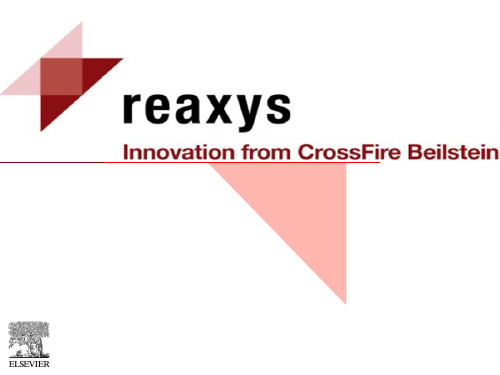
1817
1881
1988 1989 1993 1996
2007
CrossFire 1.0 Structures&Facts
CrossFire Commander V3.2 plusReactions
4
Reaxys的内容
丰富的内容,全面的高质量的数值与事实数据库
How do I navigate through this efficiently?
8
9
Information explosion
How much time will it take to filter through all these to find the relevant information?
一、关键字检索
二、结构式检索
三、 联合检索(关键字与结构式)
四、二次筛选的应用
五、 合成路线的智能设计
57
58
59
60
Reaxys的检索方式
一、关键字检索
二、结构式检索
三、 联合检索(关键字与结构式)
四、二次筛选的应用
五、 合成路线的智能设计
61
四、二次筛选功能
第一次检索结果较多,想直接筛选出符合自 己需要的检索条目
操作系统版本
必须允许Java和cookie运行
JAVA
-Symyx Draw -CrossFire Structure Editor
14
Reaxys登陆界面
网址:
15
IP绑定模式
用户注册并登陆
16
选择画图软件
17
Reaxys的检索界面—化学反应
结构式和 化学反应 输入区域
reaxy
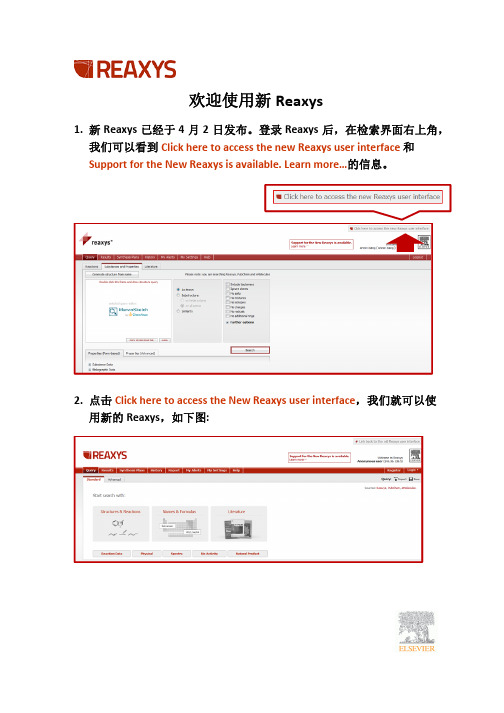
欢迎使用新Reaxys1. 新Reaxys 已经于4月2日发布。
登录Reaxys 后,在检索界面右上角,我们可以看到Click here to access the new Reaxys user interface 和Support for the New Reaxys is available. Learn more…的信息。
2. 点击Click here to access the New Reaxys user interface ,我们就可以使用新的Reaxys ,如下图:3. 点获在a.b.点击Supp 获得更多在页面的左边,From Apr available the differ 另外点击port for th 新Reaxys 我们可以读ril 2 to June to you. Fam rence.(两个击以下的三个S 链D D (he New Re s 的信息:读到:1, we will m miliarize you 个Reaxys 的个按钮,我ee the bene 链接:http://v Download th Download yo (新Reaxys eaxys is avmake both t urself with 的界面在4我们可以获得efits in our n /he new Reax our guide to 的文件介绍vailable. L the new an the redesig 月2日到6得具体的信new video!/62857608xys FAQ's o what's new ,见附件3)Learn more nd original u gned Reaxys 月1日是共息:(新Reaxys (常见问题回w in Reaxyse…,我们user interfac s and exper 共存的)。
s 视频介绍)回答,见附件s now! 们可以ces rience件2)4.在下半页的右边,我们可以注册提交相关的信息,Reaxys系统会将Newsletter自动发送至您注册的邮箱里:。
reaxys使用介绍
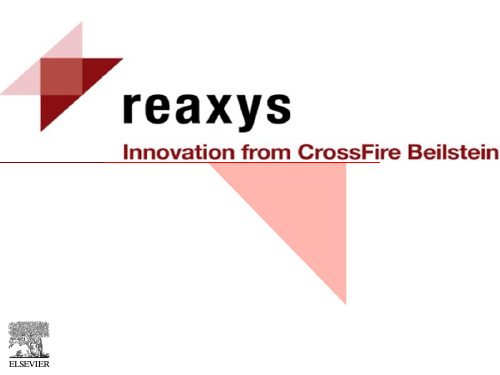
Reaxys对电脑软硬件要求
操作系统
操作系统版本
浏览器 必须允许Java和cookie运行
windows
Windows 2000 Windows XP Windows Vista
Windows 7
IE 6/ IE 7 Firefox 2/ Firefox 3
JAVA
Sun Microsystems Java Version 5.0 or Java Runtime Environment (JRE) Version 1.5.0
Reaxys
Patent
Beilstein
2800万反应 1800万物质 400万文献
Gmelin
5
Crossfire简介
CrossFire Beilstein Database :世界最全的有机化学数值和事实库 时间跨度从1771年至今 化学结构相关的化学、物理等方面的性质 化学反应相关的各种数据 详细的药理学,环境病毒学,生态学等信息资源
How do I filter factual from speculative data?
8
9
How much time will it take to filter through all
Inftohersmeatotfiinod ntheerexlepvlanotsinifoormnation?
32
一、精确结构式检索
33
检索结果显示
34
35
36
2、子结构检索
输入一个基本结构,我们可以查询包含这个分子骨架的所有化学结构。
37
38
39
40
41
子结构查询2:不定位的R取代基的查询
488_Reaxys快速入门手册

Reaxys Quick Reference GuideTable of Contents1 The basics – where to find what?2 Homepagesettings3 My4 Generate a structure from a nameReactionstab5 Query6 Query tab – Form-based Search7 Query tab – Advanced Search8 Results – general overview9 Results – reactions tab10 Results– filter byplans11 Synthesis12 Output13 History14 MyAlertspropertiesSubstancesandtab15 Query16 Query tab – Form-based Search17 Query tab – Advanced Searchoverview18 Resultstab(table)19 SubstancestabSubstances(grid)20 Text, authors and moretab21 Querytab22 CitationsLast revision: 2009-10-26The basicsWhere to find what?To start Reaxys, go to To find more user tips, go to . Here you can find:•Information on the coverage, usability and technical requirements of Reaxys•Registration form for the Reaxys newsletter•Training & Support information, witho Training Center giving access to various instructional materials (demos, videos, manuals)o Webinar schedule offering regular training sessions and registration formo Frequently Asked Questionso Downloads of software (plug-ins, structure editors) and of documentation (training materials)o Customer Care Contact details:Europe, Middle East, Asia and Africa +49 69 5050 4268 nlinfo@usinfo@ Americas +1 888 615 4500+1 212 462 1978 if calling outside USA & CanadaJapan +81 3 5561 5034 jpinfo@HomepageHow to find the preparation of a compound?1. Ensure the reaction tab is selected and double click the drawing pane2. Draw the desired compound structure in your preferred editor and return to Reaxys by closing the editor3. Click the search button and browse the result.Note: the default settings are such that Reaxys immediately searches for compound preparations.1Main Navigation:The following screens are available - Query - Results- Synthesis plans - History - My Alerts - My settings - Help & - Logout2Query tabs - Reactions- Substances and properties - Text, authors and more3Generate structure from name A chemical name will be translated into a structure.4 Structure/reaction windowWindow to add a structure or reaction with additional search possibilities. 5Add Reaction/Bibliographic data The Form-based Search andAdvanced Search links allow entering further reaction or bibliographic data constraints. 6 Search button Launch a search.7Command buttonsClear, load or save a query. The Load feature also supports batch querying.1345672My settingsNote: click the Save button and a confirmation that your settings have been updated is displayed. The new settings will be effective from the next time you login.1My settings Select this tab to- Modify application settings - Modify personal data - Change password2Modify application settings Select this item to specify your preferred structure editor and Highlights colors.3Structure EditorChoose your preferred editor. 4InformationFind information on the default settings used, and download the plugin required for its installation. 5Highlights colorsSelect preferred colors to highlight the searched-for structure and/or the text/data.6Back & Save buttonsConfirm new settings with Save or use Back to return to the item list.125634Generate a structure from name1Available on the Reactions andSubstances & Properties query tabs.Generate structure from name buttonClick this button to open an input field.2Input fieldEnter a chemical name as systematic name or trivial name, an InChI key, a CAS Registry number or a SMILES string. Click submit to launch structure generation.3Structure/reaction windowThe generated structure is displayed in the structure/reaction window, you can now:a) Start the search immediately. b) Edit the structure by doubleclicking the box (or by doing a right-click); modify it in the Structure editor.c) Define the search type, addfurther search conditions or/and select additional query options.Note: this option only works if the corresponding compounds are available in the Reaxys database.123Reactions query tabHow to load a saved query?1. Ensure you are on the query tab and click the load query button2. Browse to locate your saved XML file and click open1Structure/reaction boxThis window contains the requested structure or reaction, with additional query features. It is also possible to copy the structure to the Substances and Properties query tab. 2 Search as/byIf needed, define the role of the substance.3Select the search typeSelect “How” the structure should be searched: as drawn (includingpossible query features added in your structure) or as substructure search . (In a substructure search the results include additional substituents). 4Additional query optionsSelect additional options to refine your search.5Add further search conditions Click the Form-based Search or the Advanced Search links to refine your search by adding further reaction or bibliographic data constraints (e.g. a yield or/and author constraint). 6SearchClick this button to launch the search. A search progression box appears allowing you to cancel your researchor to view your hits retrieved.124536Form-based SearchNote: the Form-based Search link opens up forms containing commonly used fields for the given search form; they are grouped as either Reaction Data (such as yield or reagent name) or Bibliographic Data (such asjournal title or patent assignee). The “All Reaction fields” and “Title/Abstract/Keywords” fields are text fields; use Boolean operators to search these fields.1Reaction dataSpecify Reactant name, Product name, Reagent, Yield and/or All Reaction fields.Various selected fields are combined with the Boolean operator AND. 2 OperatorsSelect the appropriate operator from the drop-down menu.3 Selection listSelection appears when typing entry. 4 56Numeric FieldFor a numeric field select the operator followed by entering the number or range in the text box.Bibliographic dataSpecify Authors, Patent Assignee, Journal Title, Title, Patent Number, Patent Country Code, Publication Year and/or Title/Abstract/Keywords. Various selected fields are combined with the Boolean operator AND. Expand Index feature (for all search fields)The box allows convenient index browsing and multiple entryselections. Click the Transfer button to add the selected data to the query.243623Advanced SearchNote: the Advanced Search allows entry of complex and sophisticated property queries in combination with the structure or reaction queries following two ways:1. Type the query directly into the query box, with single quotes around the field data,2. If the necessary field code is unknown, locate it using the Show fields and Operators hyperlink.1 Show Fields and OperatorsSelect the necessary field code form a hierarchical list (field list navigator) available with the Show fields and operators hyperlink.2Fields CategoryClick the + sign to expand the needed fields list. 3 Needed fieldClick the needed field4 OperatorsSelect the appropriate operation from the drop-down menu.5 Expand Index feature (for all search fields)The box allows convenient index browsing and multiple entry selections.6Transfer the field dataSelect the needed data entry(ies). Click the Transfer button to add the data to the query7Check SyntaxIn case of manual entry of the query into the Advanced Search box, verify your query by clicking the Check Syntaxhyperlink.4367General overviewHave a look at the breadcrumbs at the top of the screen; it shows the actions done on your initial hitset. Click one of the red-framed boxes to quickly jump to a previous set of data or the query.1BreadcrumbsGraphical navigation helps keep track of your result analysis. 2Create AlertClick this link to create an alert. 3Reactions/citations tabReactions tab is displayed by default, but you can switch to the citations tab.4Filtered byRefine results by applying filters linked to the reaction (Yield, Record Type, Reagent/Catalyst, Solvent, Reaction Type, No. of Steps) or linked to bibliographic data(Document Type, Authors, Patent Assignee, Journal Title and Publication Year).56 7Tool barAccess Limit to Selection, Output, and Sort by features.Maximizer/minimizer toolIncrease or decrease the size of your displayed structures. Reaction resultsGives a quick overview of the results displayed with key data in a table. Display the title and the abstract, the original article or patent (full text) andaccess related information in Scopus.12 34567Reactions resultsReactions tabNote: information on the citations tab of the reactions results window can be found on page 21.Click or a structure to get a pop-upmenu with information or sub items.1 Display further options & DataReaxys – RN (Reaxys registrynumber), MF (molecular formula),CAS-RN (CAS registry number),show details (display information asphysical-, spectral- data etc), plan asynthesis (create a retrosynthesis),copy structure to clipboard2 Access bibliographic detailsDisplay the title/abstract, the full textof your reference and access Scopus.Show experimental procedureexcerpted from patents. View schemeof multi-steps sequence as asynthesis plan.3 Commercial availabilityAccess the commercial availability ofa substance and lead to appropriatecompanys (eMolecules/Symyx ACD).4 Limit to selectionSelect the important hits and click thisbutton to restrict your hitset.5 OutputExport data in the desired format.6 Sort bySort results ascending ordescending by Reaxys-RxID,reactant & product availability, Nb ofreferences, yield, MW of product orReaxys ranking (default).1234 5 62Reactions results tabFilter byNote: filter by feature allows for rapid and easy refinement of your results. Click the double arrows to expandthe selection list. Two filter options are available for each reaction specification:1.To retrieve a predefined selection list, use the by Group tab.2.To specify a filter value or range (flexible filter), select the by Value tab.1 Filter bySelect filter(s) linked to reactionspecifications:- Yield,- Record Type- Reagent/Catalyst- Solvent- Reaction Type- No. of Steps2 By Value tab: flexible filterEnter a specific value or a range torefine result sets with more options.3 By Group tab: predefined listCheck boxes to limit or excludeentries of the predefined selection.4 Limit to/exclude buttonsClick the appropriate button.5 Refine on Filter fieldClick the More button to expand thescope of the selection, and to refinefurther the filter by feature. Sort thechosen data by Value or byOccurrence.6 Filter bySpecify filter(s) linked to bibliographicdata:- Document Type- Authors- Patent Assignee- Journal Title- Publication YearEffect of Filter by ‘Yield’ on Breadcrumbs5Filter by ValueFilter by Group4Synthesis plansNote: the overall scheme of multi-step reactions can be displayed in the synthesis plans page. A click on the View Scheme hyperlink opens the multi-step sequence as a new synthesis plan for a better overview .Click or a structure in any of the results tab, choose “Plan Synthesis” to get the Synthesis Plans page. 1Undo, open and save buttons To undo last action, open or save synthesis plans. Click on the X of the tab to delete an uncessary plan. 2Copy plan to new pageOpens a new tab of your current synthesis plan, where you can develop another retrosynthesis. 3 OutputExport Synthesis plan4 Synthesis plans representation Choose horizontal tree or vertical tree for the display of your plan. 5ModifyModify discards the already defined synthetic step and proposes other preparations for the compound. 67SynthesizeClick the synthesize link to display various preparations for a compound. Click the add button of the selected step to incorporate it in your plan. Commercial availabilityAccess the commercial availability of a substance and lead to appropriate companys (eMolecules/ACD).1234567OutputNote: output function is available on each of the results screens; it allows the export of any type of hitset(reactions, substances and bibliographic data) in any desired format. In the substance details table, click select data to choose the type of property you want to export.1OutputChoose the type of results to export: 2toDefine the format of exported file: PDF/Print, XML, Microsoft Word or Excel, TXT for LiteratureManagement Systems, or RD File. 3Include the following headline Check the box and enter a headline that will be shown on each page of the document.4Output rangeDefine the hits to export: all hits,selected hits (select it before clicking the output button), or a range (enter it in the box).5Output containsDefine the type of data to export: reactions output: include structures and/or experimental procedure, all available data or identification data only.Substances output: include structures and all available data or identification data only or select data.Citations output: include structures and/or abstracts6OK buttonClick the OK button to launch your export. Click cancel to stop this action.1 24536HistoryNote: the history table displays all current-session hitsets resulting from queries or from any analysis of your results; the most recent hitsets are shown at the top of the list. Here you can also graphically combine hitsets.1Temporary listsThe upper part of the table shows all hitsets from the current session. Click View to display a list as active hitsets in the results page.Click Store (enter a filename and comment) to save a list.2Saved listsThe lower part of the table shows the hitsets stored by the user. All saved hitsets are displayed if the user is logged in to Reaxys.Click remove to delete a saved list. 3Query columnClick Edit to display the queryassociated with the hitset in the query pageNote that hitsets resulting from filtering will not display the query in this column4 5Combine hitsetsSelect two or more lists by checking the box closed to the query column; the combine hitsets button becomes available and will provide graphical tools to combine the selected hitsets in various ways.345If 2 hits selectedIf >2 hits selectedMy AlertsNote: alerts are user-defined search query stored on the Reaxys server, so that they can be accessed and retrieved any time you log-in to Reaxys. You can choose to run it either monthly or each time the database is updated. You will receive an alert email notification with a link into Reaxys allowing you to access the Alert results.1My Alerts menu displays the list of available alerts together with the given result sets.How to create an alert?Create and run a query. On the results menu, click the Create Alert link located just below the Querybreadcrumb. Fill in the Alert form and click the Save button.2View results buttonClick this link to jump to the Results menu and access the hits linked to your alert.3 4Modify alertModify the options of your alert (Name of Alert, Copy to,Comment/Description, Frequency and Email format ). Click the Save button. 5 6 DeleteCheck the box closed to the alert name column; the delete button becomes available and will discard the concerned alert.123456Substances and propertiesQuery tabHow to find information on specific compounds?1. Ensure the substances & properties tab is selected and double click the drawing pane2. Draw the desired compound structure in your preferred editor and return to Reaxys by closing theeditor3. Click the search button and browse the result.Note: Reaxys remembers the last query form used, and will reopen it in the next session; the substances andproperties query tab can then become an entry form.1 Structure/reaction boxThis window contains the neededstructure, with additional queryfeatures. Two buttons allow to copythe structure to the Reactions querytab, and also to delete it.2 Search asDefine the type of structure search:as drawn (including possible queryfeatures added on your structure), orSubstructure search.3 Additional query optionsSelect additional options to refine thesearch.4 Further optionsIf needed, add further options, suchas Include related Markush orNumber of Ring Closures …5 Add further search conditionsClick the Form-based Search or theAdvanced Search links to enterfurther substance or bibliographicdata constraints.6 SearchClick this button to start searching 123456Form-based SearchNote: the Form-based Search link opens up forms containing commonly used fields for the given search form; they are grouped as either Substance Data (such as spectra or solubility data) or Bibliographic Data (such as journal title or patent assignee). The “Search text in all facts” and “Title/Abstract/Keywords” fields are text fields; use Boolean operators to search these fields.1Substance dataSpecify Search text in all facts/search for (to add several terms in this text box, separate them with a “;”; they will be combined with the Boolean operator OR ), Identification Data, Physical Data, Spectroscopic Data, Bioactivity Data and/or Ecotoxicological Data.Various selected fields are combined with the Boolean operator AND. 2OperatorsSelect the appropriate operation from the drop-down menu; for a numeric field enter the number or range in the text box.34 Bibliographic dataSpecify Authors, Patent Assignee, Journal Title, Title, Patent Number, Patent Country Code, Publication Year and/ or Title/Abstract/Keywords Various selected fields are combined with the Boolean operator AND. Selection listSelection appears when typing entry. 5Expand Index featureThe box allows convenient index browsing and multiple entryselections. Click the Transfer button to add the selected data to the query.2542Advanced SearchNote: The Advanced Search allows entry of complex and sophisticated property queries in combination with the structure queries following two ways:1. Type the query directly into the query box, with single quotes around the field data,2. If the necessary field code is unknown, locate it using the Show fields and Operators hyperlink.1Show Fields and OperatorsSelect the necessary field code from a hierarchical list (field list navigator) available trough the Show fields and Operators hyperlink.2 Fields CategoryClick the + sign to expand the needed fields list. 3 4 Needed fieldClick the needed field.OperatorsSelect the appropriate operation from the drop-down menu.56Expand Index feature (for all fields)The box allows convenient index browsing and multiple entry selections.Transfer the field dataSelect the needed data entry(ies). Click the Transfer button to add the data to the query.7Check SyntaxIn case of manual entry of the query into the Advanced search box, check the used syntax by using the Check Syntax hyperlink.4367 6Substances and propertiesResults overviewNote: information on the citations tab of the substances results window can be found on page 21.1 BreadcrumbsGraphical navigation helps keepingtrack of your result analysis.2 Substances (grid)/substances(table)/citations tabThe substances (table) tab isdisplayed by default, but you canswitch to the substances (grid) orcitations tab.3 Filtered byRefine results by applying filterslinked to the substance (molecularweight, number of fragments,physical data, spectroscopic data,bioactivity and natural product) orlinked to bibliographic data (docu-ment type, authors, patent assignee,journal title and publication year).4 Tool barAccess limit to selection, output, sortby features.56Maximizer/minimizer toolIncrease or decrease the size ofdisplayed structures.Substances and properties resultsGives an overview of the resultsdisplayed with key data in a table.Show details & data hyperlinks allowdisplaying properties for each hit.1234 56Substances (table) tabClick Show Details to expand the list of all the types of data available for a compound. Click a specific link in the available data column to only expand the needed data.Click or a structure to get a pop-up menu with information or sub items. 1Additional information / sub items Reaxys –RN (Reaxys registrynumber), MF (molecular formula), MW (molecular weight ), CAS-RN (CASregistry number ), Show details (display information as Structure/compound data ), Plan a synthesis (create your retrosynthesis ), Copy structure to clipboard2Commercial availabilityAccess the commercial availability of a substance and lead to appropriate company’s (eMolecules/ACD). 3Show/hide details button 4Structure/compound data Find details about structure/ compound.5Available dataLinks to all available data (from organic, inorganic & organometallic sources). Data excerpted from Gmelin has a from Gmelin flag.6Sort bySort results ascending ordescending by Reaxys-RN, Comm Availability, Molec Formula, Nb Fragments, Publication Year, MolWeight and Nb of References (default).1234556Substances (grid) tab1 Grid viewFor a quick overview results are displayed in a grid.2Additional Information/sub items Click a structure to get a pop-upmenu leading to additional information or sub items.Reaxys –RN: Reaxys registry number MF: molecular formula MW : molecular weightCAS-RN: CAS registry numberShow Details: display information as Structure/compound dataPlan a synthesis: develop your retrosynthesisCopy structure to clipboard3Commercial availabilityAccess the commercial availability of a substance and lead to appropriate company’s (eMolecules/ACD). 4OutputExport results in the desired format. 5Available data for this substance Various red hyperlinks display the information available by substance.13452Query tabNote: in the Quick Search box you can use and enter the following Boolean operators: AND, OR, PROXIMITY, NEAR and NEXT.1Search pageEnter Quick Search,Author(s)/Assignee(s), Journal Title, Patent Number, Patent Country, and/or Publication Year.Different specified fields arecombined with the Boolean operator AND.2Quick SearchEnter free text and combine it with the Boolean operators of your choice. If needed use truncations. Truncation:”*” = any number of characters “?” = one character3 Text field/selection listSelection appears when typing entry. 4Expand Index featureThe box allows convenient index browsing and multiple entry selections.If several terms are chosen in one field, they are combined with the Boolean operator OR (;).5Entry exampleHints how to enter your search term are displayed below each of the fielddata boxes.12453Citations tabReactions - and Substances & Properties - citations tabs have almost the same layout and content as the bibliographic citations tab. The only differences are the presence of one additional link on each of those tabs and additional filters:- Reactions results/citations tab: presence of Hit Reactions in this article (# out of total #) link- Substances & properties results/citations tab: presence of Hit Substances in this article (# out of total #) link1Filter byRefine search results by applying filters (document type, authors, patent assignee, journal title and publication year).2OutputExport results in an appropriate format.3Sort bySort results ascending ordescending by Document Type, Authors, Journal Title or Publication Year (default).4Abstract/Reactions/Substances Display the abstract, and show all reactions or show all substances which are related to the article. 5SourceFind here the literature reference. Display the original text with the full text link and access related information in Scopus.12354。
Reaxys数据库
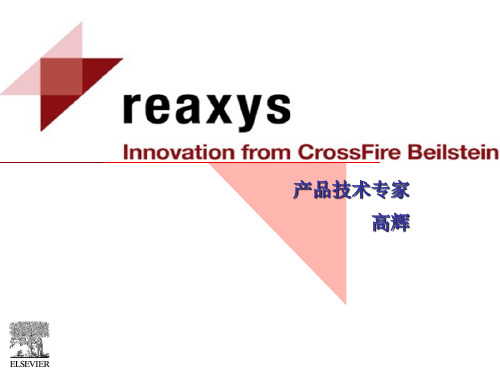
进入“My Settings”
进入“Modify Application Settings”
下载并安装 “Reaxys Structure Editor Plugin”
选择需要的画图软件, 如ISIS Draw或Symyx Draw
点击“Save”进行保存设置
Reaxys的检索界面—化学反应
结构式和 化学反应 输入区域
Patent Chemistry—化学专利数据库 Gmelin—当今最全面的无机与金属有机化学事 实数据库 Reaxys — Crossfire的升级产品 PharmaPendium —综合性药物安全性数据的关键来源
Reaxys 发展历史介绍
Reaxys的发展历程
Gmelin Handbook
Beilstein Handbook
-Symyx Draw -CrossFire Structure Editor
Reaxys登陆界面
网址:reaxys
IP绑定模式
用户注册并登陆
选择画图软件
在Reaxys中注册用户和选择画图软件的操作流程
在电脑中安装需 要的画图软件, 如ISIS Draw或
Symyx Draw
在Reaxys中注册用户 使用注册的用户进行登陆
检索结果显示
检索结果显示
例2: 检索包含特定信息的文献
检索结果显示
ScienceDirect:全学科的全文数据库,得到130多 个国家认可,中国用量最高的外文期刊数据库。
Reaxys的检索方式
一、关键字检索 二、结构式检索
三、 联合检索(关键字与结构式) 四、二次筛选的应用 五、 合成路线的智能设计
这里只选择了编号为1,3,5三条记录作为选择的记录
- 1、下载文档前请自行甄别文档内容的完整性,平台不提供额外的编辑、内容补充、找答案等附加服务。
- 2、"仅部分预览"的文档,不可在线预览部分如存在完整性等问题,可反馈申请退款(可完整预览的文档不适用该条件!)。
- 3、如文档侵犯您的权益,请联系客服反馈,我们会尽快为您处理(人工客服工作时间:9:00-18:30)。
解决问题的方法
互联网资源
6
信息爆炸
怎样有效率的查 找所需信息?
无效信息太多, 有效信息太少。
信息爆炸 7 从文献中提取信息需要多长时间?
1.1 设计理念
出自于化学家,服务于化学家!
Reaxys 为用户提供
快速检索功能,可以查到合并了化学反应和化合物数据的相 关高质量数据; 唯一的数据提取标准,可以确保信息的可靠性、一致性和可 信度; 直观易用的界面; 可再现、经验证的相关实验数据; 独特的工具,让您能够评估搜索结果项、设计合成策略、共 享数据以及执行更多功能。
反应检索
检索特定反应或反应类型(例如:醇转变为硫醇的反应) 筛选涉及特定物质的反应 • 物质作为反应溶剂、催化剂、反应物等 • 物质作为反应产物,即物质合成,Reaxys可以智能化的
设计合成路线
2.2 反应检索
为什么是Reaxys,而不是SciFinder?
独具特色的路线合成器,比较不同的反应路线,辅助您选 择最优反应路线; 具有许多SciFinder不具有的化合物结构定义功能,使您的 检索更有效率; 无需安装客户端,检索方便。 ……
jpinfo@ cninfo@
+81 –3 – 5561 5034 +86 – 10 - 85208800
谢谢!
Reaxys是一种基于网络的解决方案,专门服务于从 事有机化学、无机化学、有机金属化学及相关学科的
药物化学家 合成化学家 过程工程师 化工工程师 材料化学家
Reaxys全方位支持教学和研究工作,可更轻松快捷 地为所有化学家释疑解惑、提供所需数据,并使其顺 利投入实验室工作,从而取得优秀成果。
2. Reaxys检索
此外还支持 CrossFire SE; Symyx Draw; Symyx ISIS Draw; CambridgeSoft ChemDraw
问题1 寻找抗紫外线防晒霜原料
问题2 高产率的醇类转变为硫醇的反应
定义取代数目
问题2 高产率的醇类转变为硫醇的反应
包含错误结果!!
怎样消除?
问题2 高产率的醇类转变为硫醇的反应
此外,Reaxys还为您提供?
2.2 反应检索
强大的二次筛选功能 便捷的排序功能 直观的实验细节信息 原始文献,可链接到 ScienceDirect, Scopus等数据库
……
2.3 文本检索(专利信息)
2.3 文本检索(专利信息)
3. 现场演示
截屏演示 在线演示
轻松访问:
• 总是能找到您所需要的信息。
49
4.1 访问方式
• 授权机构的IP地址范围均可以随意访问; • 培训中心:
• /training-center •
4.2 客户服务
帮助 (化学家在线答疑)
Reaxys为您从科研杂志与专利中提取有价值的化学性质和 反应细节信息…
1H NMR 300 MHZ
便捷的链接Scopus & ScienceDirect数据库
1.2 数据库组成
有机化学
全球最全的有机化 学数值和事实库 化学结构相关的化 学、物理等方面的 性质;化学反应相 关的各种数据 详细的药理学,环 境病毒学,生态学 等信息资源
• 科研杂志——物化数据;生物活性;自然产物;反应产率,反应条件,反 应物/溶剂;催化剂;商品等;
• 专利——实验过程和光谱信息数据(NMR; IR; MS; UV/VIS)。
化学反应路线合成:
• 设计多步骤反应,比较可供选择的反应路线,帮您做出快速而准确的判断。
Reaxys排序,过滤和分析工具:
• 很容易找到、过滤和分析所得到数据,效率很高。
无机化学
当今最全面的无 机与金属有机化 学数值与事实数 据库 详细的理化性质, 地质学,矿物学, 冶金学,材料学 等方面的信息资 源
化学专利
化学专利数据库 世界知识产权组 织,美国专利局, 欧洲专利局专利 信息
1.2 数据库组成
数据包括:
• 化学反应
• 化合物
• 实验测量得到的化合物性质数据
• 物理,生物,应用类相关数据
化学家感兴趣的事?
1. 是什么? • 新物质? 专利保护? • 物化性质(密度,粘度,折射率, 生成焓等)?
2. 什么用途? • 反应物? 溶剂? 催化剂? • 生物活性? 药理性质? • 毒性?
3. 怎样得到? • 已知制备方法? • 对制备方法进行改进?
解决问题的方法
图书馆资源
物化数据手册
反应信息手册
独特的标记工具!!!
问题2 高产率的醇类转变为硫醇的反应
强大的筛选功能,希望高产率 。
问题2 高产率的醇类转变为硫醇的反应
观察发现,反应物可能包含羰 基结构,需要将OH →SH,但 是不希望C=O →C=S!!!
Reaxys能帮您很好的解决问 题(SciFinder maybe not)!
问题3 合成路线设计
• A61K Medicinal Preparations* (医用制剂)
• A01N Biocides, Agrochemicals (杀生剂)
• C09B Dyes (染料)
......为您提供其他数据库不能提供的
2千8百万种反应 1千8百万种物质 4百万条引用 数据库不断更新…
1.3 用户
2.1 物化性质检索
为什么选择Reaxys?
数据广泛,包含有其他任何数据库都不包含的数据; 重要化合物的基础物性被反复测量,Reaxys给出多个测量值 参考; 注明数据来源,可查阅到原始文献、了解采用的测定方法、 测量仪器、样品来源及纯度、保证数据的准确性和权威性; 强大的筛选功能,无可比拟。
2.2 反应检索
问题4 卤素加成双键的类型反应
对环内双键 加成比较感 兴趣?
问题4 卤素加成双键的类型反应
问题4 卤素加成双键的类型反应
您还可以设置 顺式加成或反 式加成。
问题5 Suzuki偶合反应制备取代联苯文献检索
问题5 Suzuki偶合反应制备取代联苯文献检索
4. 总结
提供经过确认的可靠的实验数据
文献表明 具有此结构 的化合物, 可能是潜在 的抗肿瘤药 物。
问题3 合成路线设计
问题3 合成路线设计
问题3 合成路线设计
问题3 合成路线设计
问题3 合成路线设计
Hale Waihona Puke 问题3 合成路线设计V.S.
问题3 合成路线设计
问题3 合成路线设计
Reaxys最闪亮的功能:智能化的设计合成路线 帮助您对比不同的合成路线,优化合成路线 轻松方便的导出结果 更多?可以访问Training Center
March 6, 2020
Reaxys 全新的辅助化学研发的在线解决方案
Elsevier
日程
1. Reaxys介绍
设计理念 数据库组成 用户
3. 现场演示
截屏演示 答疑
2. Reaxys检索
物化性质检索 反应检索 文本信息检索
4. 总结
访问方式 客户服务
1.1 设计理念
请注意检索方法和技巧;
问题1 寻找抗紫外线防晒霜原料
调研已知
结构修改
问题1 寻找抗紫外线防晒霜原料
高级检索项 性质筛选
根据性质筛 选符合条件 的物质
问题1 寻找抗紫外线防晒霜原料
有商品
问题1 寻找抗紫外线防晒霜原料
定义 R 基团
检索结果表明大量的 物质都具有羟基,烷 氧基或烷基。
Marvin Sketch
1
2
3
1
2
3
反应检索 物化性质检索 文本检索
2.1 物化性质检索
• 宏观数据
熔点,沸点,临界参数,饱 和蒸汽压,折射率,热容, 摩尔蒸发焓等
• 微观数据
分子偶极矩,电离能,键参 数(键角、键长、键能)等
2.1 物化性质检索
性质检索
查找特定物质的性质( 例如:25oC时,酒精密度是多少?) 筛选符合特定条件的物质(例如: 25oC时,密度在0.8– 1.1 g/cm3 且粘度在0.02 – 0.12P 的溶剂?)
数据来源:
• 精选化学重点期刊(1771 -)(有机化学,金属有机化学,无机化学)
• 精选有机化学专利出版物(1869 - )
• 精选英语专利出版物(世界知识产权组织,美国专利局,欧洲专利
局,1976 -)
内容涵盖以下国际专利分类(IPC):
• C07
Organic Chemistry (有机化学)
